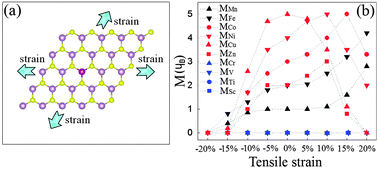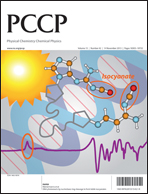Controlling magnetism of MoS2 sheets by embedding transition-metal atoms and applying strain
Abstract
Prompted by recent experimental achievement of transition metal (TM) atoms substituted in MoS2 nanostructures during growth or saturating existing vacancies (Sun et al., ACS Nano, 2013, 7, 3506; Deepak et al., J. Am. Chem. Soc., 2007, 129, 12549), we explored, via density functional theory, the magnetic properties of a series of 3d TM atoms substituted in a MoS2 sheet, and found that Mn, Fe, Co, Ni, Cu and Zn substitutions can induce magnetism in the MoS2 sheet. The localizing unpaired 3d electrons of TM atoms respond to the introduction of a magnetic moment. Depending on the species of TM atoms, the substituted MoS2 sheet can be a metal, semiconductor or half-metal. Remarkably, the applied elastic strain can be used to control the strength of the spin-splitting of TM-3d orbitals, leading to an effective manipulation of the magnetism of the TM-substituted MoS2 sheet. We found that the magnetic moment of the Mn- and Fe-substituted MoS2 sheets can monotonously increase with the increase of tensile strain, while the magnetic moment of Co-, Ni-, Cu- and Zn-substituted MoS2 sheets initially increases and then decreases with the increase of tensile strain. An instructive mechanism was proposed to qualitatively explain the variation of magnetism with elastic strain. The finding of the magnetoelastic effect here is technologically important for the fabrication of strain-driven spin devices on MoS2 nanostructures, which allows us to go beyond the current scope limited to the spin devices within graphene and BN-based nanostructures.


 Please wait while we load your content...
Please wait while we load your content...